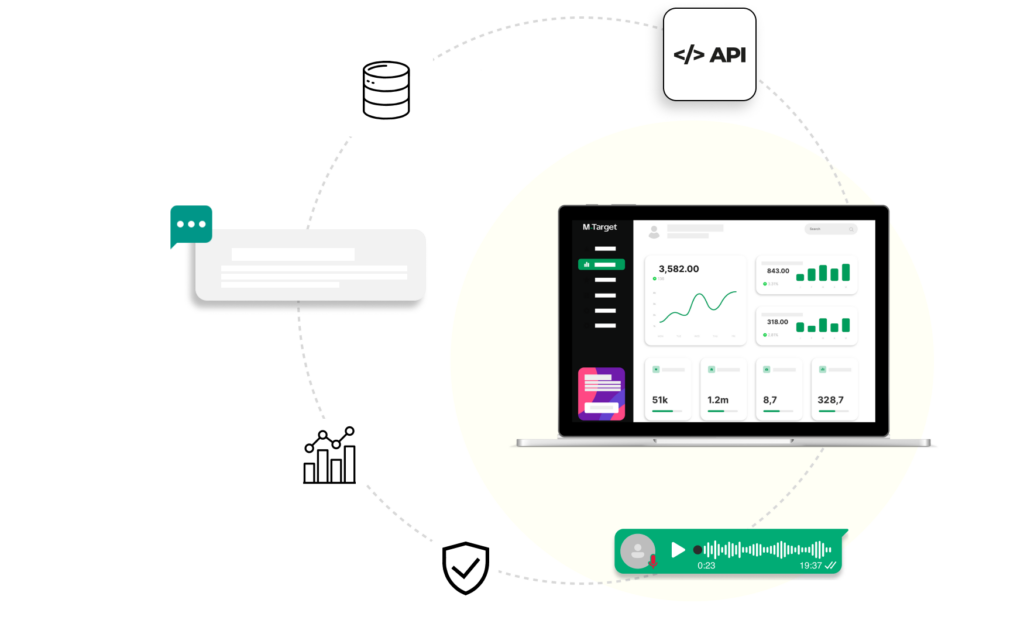SMS API: Automation and simplicity



Understanding how an SMS API works
An SMS API acts as a technological bridge between your IT system and our SMS sending system. In practice, it enables your digital tools (CRM, ERP, business applications) to communicate directly with this gateway. The gateway takes care of routing the SMS messages to the telecommunications networks. This facilitates the sending and automated management of SMS campaigns.



Facilitate the integration of our SMS API with our dedicated resources.
A powerful channel for modernizing your strategy
The effectiveness of using an API to send SMS messages rests on four main pillars: automation, engagement, immediacy and cost-effectiveness. Let’s explore these strengths to understand how to integrate this tool into your marketing or operational arsenal.
An SMS API is a powerful automation lever for optimizing your operational processes and reducing repetitive tasks.
In particular, it enables :
- Automated appointment reminders
- Scheduling shipping notifications
- Instant transmission of order confirmations
These features eliminate the need to mobilize human resources for time-consuming operations.
By adopting it, companies gain in efficiency and productivity. They can devote their resources to more strategic tasks, such as data analysis or product innovation.
One of today’s major marketing challenges is to maintain a constant link with the customer. The SMS API effectively meets this challenge thanks to its ability to deliver targeted, personalized messages.
Unlike e-mails, which often drown in an overloaded inbox, SMS messages enjoy an impressive 98% open rate.
Share with others:
- Promotions
- Exclusive invitations
- Satisfaction surveys directly on the customer’s phone
Take the case of a fast-food restaurant chain. During a promotional period, the company could schedule a special offer, such as a discounted menu, to be sent to thousands of customers.
The company can also personalize its messages by adapting them to customers’ purchasing history. For example, it could automatically send a promotion on menus they order frequently.
This kind of instant, relevant communication not only builds commitment, but also long-term loyalty. A customer who feels listened to and valued is more likely to return.
The speed of SMS transmission is an undeniable asset. Unlike e-mails, which are often slowed down by filters or easily ignored, SMS messages reach their recipients in a matter of seconds. This immediacy is particularly valuable for sensitive or urgent communications.
Take, for example, verification codes or appointment confirmations. These messages require immediate transmission and reliable reception. Thanks to its low latency rate, SMS ensures near-instantaneous reception, ideal for avoiding errors and abandonment.
The immediacy of SMS is also accompanied by ease of use for the recipient. One click is all it takes to interact with rich SMS: validate a registration, confirm a payment or cancel an appointment. This practicality reinforces the user experience and enhances your brand image.
If the effectiveness of SMS is undeniable, so is its profitability. With an extremely low average cost per SMS, this channel offers excellent ROI, especially for mass SMS campaigns or recurring notifications.
To better understand the potential savings for your company, request a quote now! You’ll be amazed by the accessibility of this channel.
Easy, flexible integration
Easy integration into your in-house tools
Our SMS API integrates seamlessly with internal management tools, such as CRMs, ERPs and e-commerce platforms.
This compatibility enables centralized dispatch management and automatic data synchronization.
A CRM can use the API to automate the dispatch of messages at different stages of the customer journey.
For example, a welcome SMS can be sent after registration, followed by an alert to inform about the status of an order.
Scalability to keep pace with company growth
Scalability is a key asset of the SMS API. It is capable of handling ever-increasing volumes of messages without any loss of performance.
In concrete terms, a start-up can begin by sending a few hundred messages per month. Within a few years, it can manage millions of SMS messages a year, without changing tools or suffering interruptions.
Our infrastructures enable you to move easily from basic to intensive use.
Compatibility with different programming languages and platforms
Our SMS API also stands out for its compatibility with a multitude of programming languages, including PHP, Python, Java and Ruby. This technical flexibility ensures that it can be custom integrated into a variety of systems, whatever the company’s IT architecture.
The API also adapts to a variety of infrastructures, from reservation solutions to mobile applications and internal management platforms.
This speeds up implementation times while maintaining optimum robustness.
SMS API in practice
By integrating this system into your business processes, you can simplify your interactions with your customers while optimizing your operations. From e-commerce to financial institutions and the healthcare sector, real-life applications of our APIs illustrate their usefulness and relevance in a variety of environments.
In e-commerce, where the customer experience is at the heart of everything, an API designed to send SMS messages plays a key role.
It automates essential tasks:
- Order confirmation, to reassure customers as soon as a purchase has been validated.
- Shipment tracking, with real-time notifications on delivery status.
- Product returns, thanks to simplified reminders and clear communication on procedures.
- Promotional offers, personalized and sent at the right time to boost sales.
Security and responsiveness are major challenges for banks and financial institutions.
An API dedicated to sending SMS enables us to meet these requirements, with a variety of use cases:
- Security notifications, such as alerts on suspicious transactions.
- Bank alerts, to inform you of account movements, direct debits or due dates.
- 2FA validation (two-factor authentication), which adds an extra layer of security when logging on or paying online.
The healthcare sector also benefits from an SMS API to improve services and patient relations.
Use cases include :
- Appointment reminders, to reduce absences and optimize schedule management.
- Test notifications, to keep patients informed of results or necessary preparations.
- Sending prescriptions, to give patients easier access to their prescriptions.
Frequently asked questions
Reception times depend mainly on the operator’s network and system load. As a general rule, SMS messages sent via an API are received almost instantaneously, in a matter of seconds. However, delays may occur in rare cases, such as network overload.
Yes, an SMS API is compatible with all operating systems, as it relies on standardized protocols such as HTTP or REST, which are independent of the underlying system. Whether your infrastructure runs on Linux, Windows or macOS, the API can function without restriction, provided that the programming language or libraries used support these protocols and are adapted to the runtime environment.
For more information, please visit our dedicated developer page. It lists all the resources and technical details relating to our SMS API.
Yes, a modern SMS API can usually segment contacts directly. This can be done according to defined criteria, such as location, behavior or demographics. By segmenting, you can send ultra-targeted and relevant messages, increasing the effectiveness of your campaigns. To find out more, visit our developer page where you’ll find additional resources and technical information.